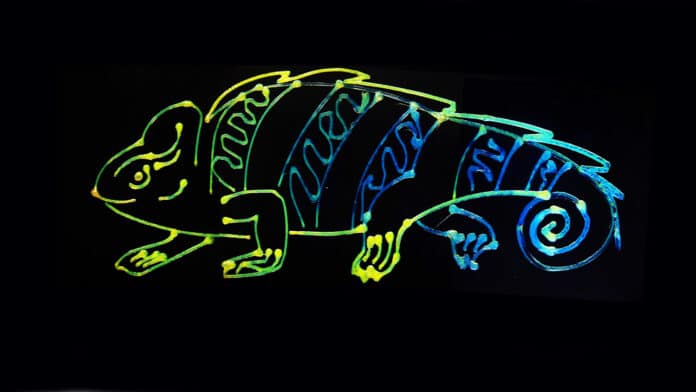Researchers at the University of Illinois Urbana-Champaign have drawn inspiration from the remarkable color-changing abilities of chameleons to develop a sustainable technique for 3D printing multiple dynamic color objects from a single ink.
By changing the strength of UV light while printing, researchers were able to control the color of the printed material and achieve a wide range of colors using just one type of ink. This new technique could potentially have important applications in fields such as art, design, and manufacturing.
“By designing new chemistries and printing processes, we can modulate structural color on the fly to produce color gradients not possible before,” said Ying Diao, an associate professor of chemistry and chemical and biomolecular engineering at the University of Illinois Urbana-Champaign and a researcher at the Beckman Institute for Advanced Science and Technology.
The study conducted by Diao and her colleagues introduces a UV-assisted direct-ink-write 3D printing approach that allows for the alteration of structural color during the printing process. The researchers achieved this by controlling the evaporative assembly of photo-cross-linkable bottlebrush block copolymer solution ink through tuning light.
The resulting printed material exhibits vibrant structural color due to the nanoscopic lamellar structures formed post-extrusion. By dynamically modulating UV-light irradiance during printing, the color of the printed material can be programmed to access a broad spectrum of visible light with a single ink, enabling the creation of color gradients that were not previously possible.
“Unlike traditional colors, which come from chemical pigments or dyes that absorb light, the structural colors abundant in many biological systems come from nano-textured surfaces that interfere with visible light. This makes them more vibrant and potentially more sustainable,” said Sanghyun Jeon, the lead author and a graduate student in the Diao Lab.
The team successfully demonstrated a new method for controlling structural color across the visible light spectrum by combining cross-linking chemistry with additive manufacturing. They can produce structural colors in the visible wavelength spectrum, ranging from deep blue to orange. Unlike an artist who would require multiple paints to achieve such a gradient, the research team uses a single ink and modifies its printing technique to create the color variation.
The researchers believe this breakthrough has wide-ranging applications, including photonic resins and 3D-printed structures. It can be a versatile solution for achieving vibrant and customizable colors in various products by dynamically controlling color during manufacturing.
“The work shows the benefit of us all having learned from each other by sharing our successes and challenges,” said coauthor Simon Rogers, an associate professor of chemical and biomolecular engineering.
“Only by working together can we design this system at the molecular level to yield such fascinating properties,” said coauthor Charles Sing, an associate professor of chemical and biomolecular engineering and materials science and engineering.
Journal reference:
- Sanghyun Jeon et al, Direct-ink-write cross-linkable bottlebrush block copolymers for on-the-fly control of structural color. Proceedings of the National Academy of Sciences, 2024. DOI: 10.1073/pnas.2313617121
